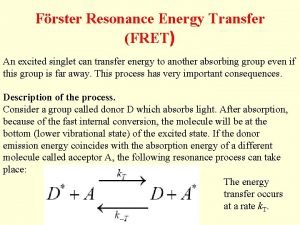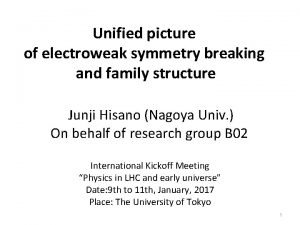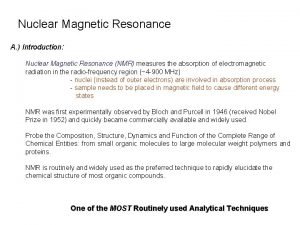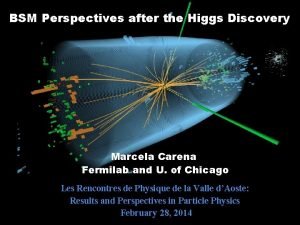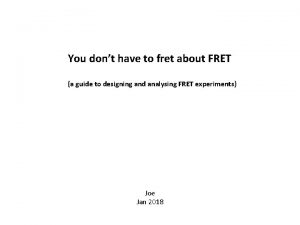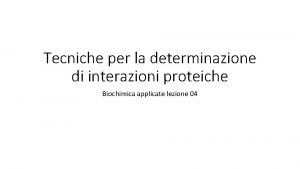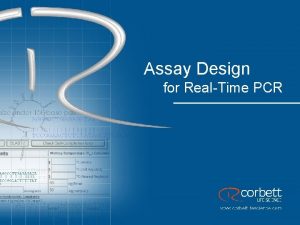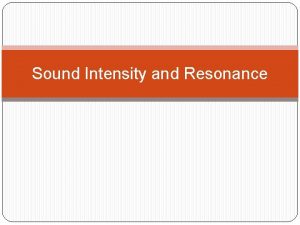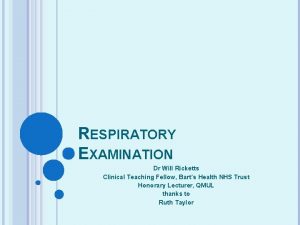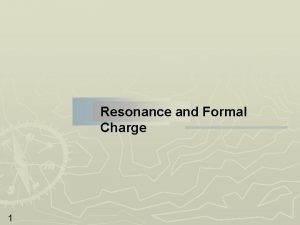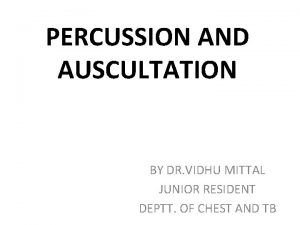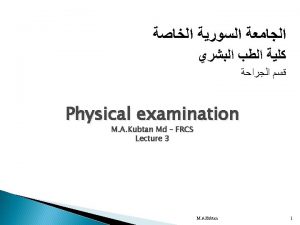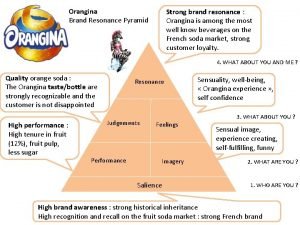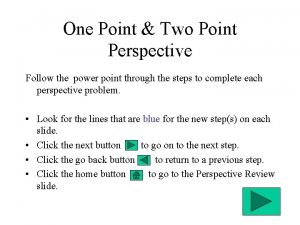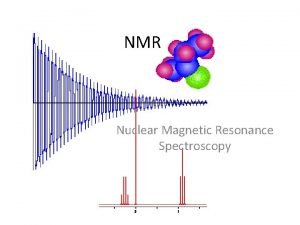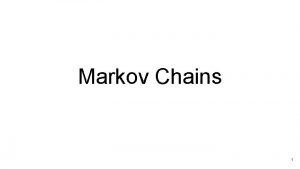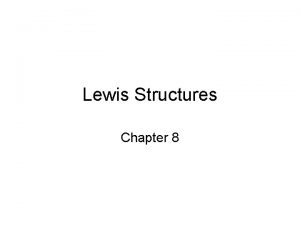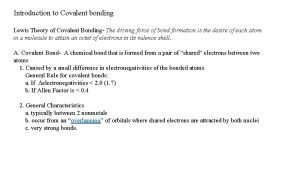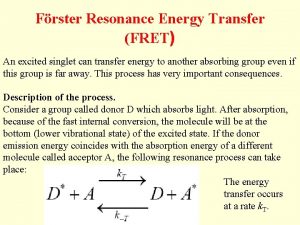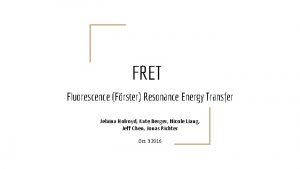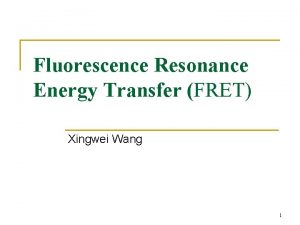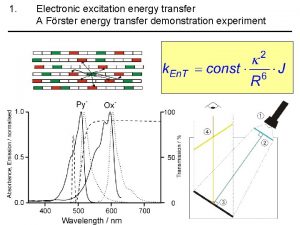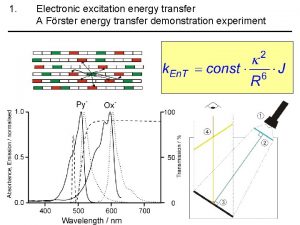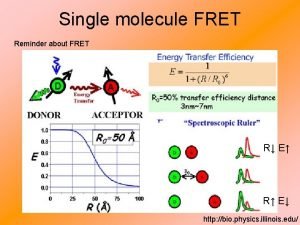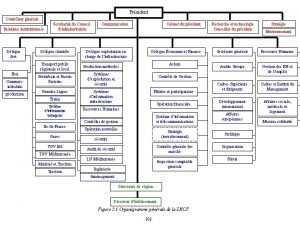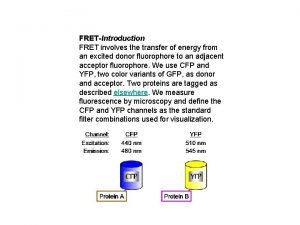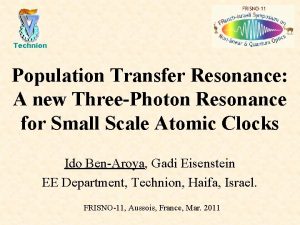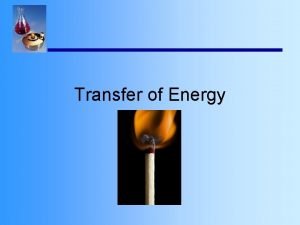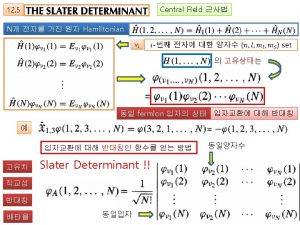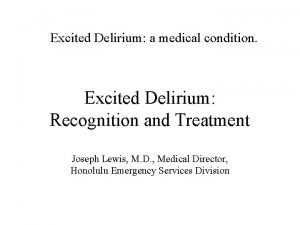Frster Resonance Energy Transfer FRET An excited singlet
























- Slides: 24

Förster Resonance Energy Transfer (FRET) An excited singlet can transfer energy to another absorbing group even if this group is far away. This process has very important consequences. Description of the process. Consider a group called donor D which absorbs light. After absorption, because of the fast internal conversion, the molecule will be at the bottom (lower vibrational state) of the excited state. If the donor emission energy coincides with the absorption energy of a different molecule called acceptor A, the following resonance process can take place: The energy transfer occurs at a rate k. T.

The acceptor then rapidly decays to the bottom of the excited state. From this level the acceptor molecule can decay by fluorescence emission or by non -radiative processes. Because of rapid internal conversion, the process from A* to D is very unlikely to occur unless the donor is of the same kind of the acceptor. This process is called sensitized emission of the acceptor A. This process strongly depends on the distance between the two groups. The complete theory was developed by Förster. Sometimes this process is called Förster cycle. Förster calculated the rate of transfer to be

τD is the lifetime of the donor in the absence of the acceptor, R is the distance between the two groups and Ro is called the Förster characteristic distance, defined by J is a measure of the spectral overlap, n is the refractive index of the medium between acceptor and donor, ΦD is the quantum yield of the donor and κ 2 is a complex geometrical factor which depends on the relative orientation of donor and acceptor.



Model Calculations for the Orientation Factor

Model 1 One transition moment is fixed at an angel Θ to the separation vector R; The other vector has a random orientation with respect to R allowing for uniform distribution over the volume of a sphere. Averaging is thus to carry out for the second transition moment which makes an angle Θ’ with R over all Θ’ and all azimuthal angles φ with weighting element ni = sin Θ’dΘ’dφ. D Θ’ R Θ fix A

Model 2. In random solution, both transition moments agerage over all orientations. In model 1, the average is already done for one transition moment. Now, we have to do it for the other transition moment (which was kept at fixed orientation), as well.

Energy transfer studies give information about • distance between groups • orientation of two groups and • the refractive index between two groups Notice, that D and A can be the same kind of molecule provide emission and absorption overlap.

How to perform an energy transfer experiment? 1. Define E = efficiency of transfer where D refers to donor Where k. T is the rate of transfer and ki are all other deactivation processes. Experimentally, E can be calculated from the 1) fluorescence lifetimes or 2) intensities of the donor determined in absence and presence of the acceptor.


2. Prepare two samples: One containing only the donor, the other containing donor and acceptor. If the concentration of the donor is the same, the intensity of the fluorescence of the donor can be measured and compared in both samples. If we assume that the only influence of the acceptor is to introduce the k. T term, and that there is no direct interaction between donor and acceptor then D* = D

3. If the acceptor is fluorescent, then it is possible to measure the intensity of the acceptor fluorescence in the absence and presence of the donor. Consider the following configuration! The donor absorbs at λ 1 and emits at λ 2. The acceptor absorbs at λ 3 and emits at λ 4. The acceptor absorption band may superimpose to the absorption of D. The sample is excited at λ 1. The fluorescence at λ 4 of the acceptor can be observed in the absence of the donor to check if there is any contribution of direct acceptor excitation.

In presence of the donor, the total fluorescence intensity at λ 4 is Measuring FA and FA+D, the energy transfer efficiency E can be obtained

4. An independent measurement of E can be obtained by comparing the decay time of the donor in the presence and absence of the acceptor. The efficiency of energy transfer can be written as using equation we obtain For a given value of Ro, a measurement of E can give R. Notice the dependence on R 6. The value of Ro depends on many factors, but it generally ranges from 5 to 50 Ǻ.


What value of κ 2 should be used ? Except in very rare case, κ 2 can not be uniquely determined in solution. 1. We can assume isotropic motions of the probes and a value of κ 2 = 2/3, and verify experimentally that it is indeed the case. By swapping probes: The environment of the probe will be different and if κ 2 is not equal to 2/3, because orientations of the probes are not dynamically average (during the lifetime of the probe) due to restricted motions of the fluorophores, then the distance measured by FRET will be different. By using different probes: If the distance measured using different probe pairs are similar (taking into account the size of the probes) then the assumption that κ 2 is equal to 2/3 is probably valid. 2. We can calculate the lower and upper limit of κ 2 using polarization data (Dale, Eisinger and Blumberg: 1979 Biophys. J. 26: 161 -93).

Elementary energy transfer theory Different processes a) Trivial process: Emission of a photon by D* and absorption by A. The probability of this process depends on R-2 and orientation. If A ≠ D the apparent lifetime of D is not influenced by the presence of A. b) Radiationless energy transfer D*→ A. Give a system with two states ψ1 and ψ2 the transition probability between ψ1 and ψ2 is dependent on the square of the matrix element Resonance Integral V is the interaction that causes transition. Assume D*A and DA* representing the two states. Several mechanisms can operate.

1. Coherent transfer: the phases of the excitation of a number of molecules are correlated. This happens in molecular crystals with A = D. 2. Incoherent transfer: the phase relation between excited molecules D* is lost rapidly. In solution dephasing occurs in few picosecond due to random interactions with the solvent. a. Very weak coupling │β│ < ∆E, where ∆E is the amplitude of the energy fluctuations in the surrounding matrix (solvent), for example from thermally excited phonons. In this cage, D* undergoes many internal vibrations before exchanging its electronic energy with A. b. Weak coupling │β│ ≈ ∆E Only a few vibrations occur. c. Strong Coupling. The excitation energy cannot be thought as localized either in A* nor D*. Also the absorption spectrum is not the sum of A and D. In biology only weak coupling occurs.

Förster Theory (1946). Assume energy levels of D and A are the same. Relevant states as shown below Assume only two electrons are involved in the process. The relevant anti-symmetric normalized wavefuntions are

V is the coulombic interaction between electrons 1 and 2

This is valid in the weak coupling case. Otherwise wavefunctions ψD and ψA are no longer appropriate. Spin selection rules require conservation of the spin of the system (D. . . A)* and forbid transition T 1 ↔ S 0 in a molecule alone. Hence only the exchange mechanism can contribute to triplet D to triplet A transfer. For singlet-singlet transfer both exchange and coulombic processes can occur. The exchange process is effective only if there is spatial overlap of wavefunctions of D* and A. This case can occur only during contact of D* with A* (typically below 5Å) Consider only the coulomb term. Do multipole expansion of 1/r. The dipole term is dominant. βc = βdipole-dipole ≈ MDMAR-3 n-2 where MD and MA are the transition moments of donor and acceptor, R is the distance and n the index of refraction at optical frequencies. (Only if MD or MA are zero, quadrupole or other higher order terms can be important).

Apply Fermi's "golden rule" to calculate the transition rate constant. f is a measure of the density of interaction between the initial and final state of the real system. If there is only one acceptor at a distance R from the donor: a) for exchange b) for Coulomb where R 0 is the Förster radius: J: spectral overlap C: constant

 Frster
Frster Energy energy transfer and general energy analysis
Energy energy transfer and general energy analysis Energy energy transfer and general energy analysis
Energy energy transfer and general energy analysis Higgs singlet
Higgs singlet Doublet triplet quartet
Doublet triplet quartet Singlet doublet triplet quartet quintet
Singlet doublet triplet quartet quintet Higgs singlet
Higgs singlet Higgs singlet
Higgs singlet Fret efficiency formula
Fret efficiency formula Saggio fret
Saggio fret Rt pcr primer efficiency
Rt pcr primer efficiency Uitwerpselen fret
Uitwerpselen fret A wave is a disturbance that transfers energy
A wave is a disturbance that transfers energy Sound intensity and resonance
Sound intensity and resonance Tactile fremitus test
Tactile fremitus test Nitric acid formal charge
Nitric acid formal charge Hyperresonance sound
Hyperresonance sound Tympanic percussion sound
Tympanic percussion sound Chocl lewis structure
Chocl lewis structure Brand resonance pyramid
Brand resonance pyramid Stairs in 3 point perspective
Stairs in 3 point perspective Resonance in nmr
Resonance in nmr No arrows
No arrows Phosphate ion lewis structure
Phosphate ion lewis structure Lewis structure for scn-
Lewis structure for scn-
